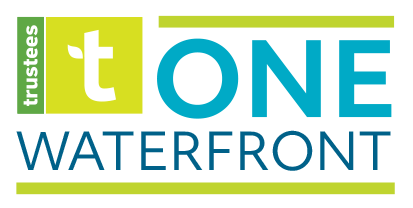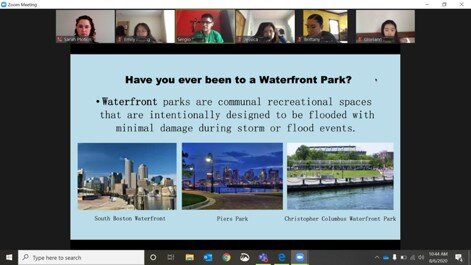Neighborhood beautification, and reimagined public space | Waterfront Ambassadors photo diary
It was an active fifth week for the Waterfront Ambassadors, as the Boston teens prepped for a community art project, and led their first workshop.
The community art project is being developed in partnership with Carolina Aragón, local artist and UMass-Amherst Landscape Architecture and Regional Planning Assistant Professor. The art pieces will focus on local impacts of climate change, and will be informed by public surveys, distributed by the Ambassadors within their communities, to learn about what their neighbors may have observed, and how they feel, about these impacts.
“We also did an activity where the Ambassadors had to find places in their neighborhoods that looked like they could have more green space,” explained program manager Sarah Plotkin. “They then had to draw a picture reimagining that space. You can see some of their drawings in this week’s photo diary!”
Another project that had many of the teens excited this week was the opportunity to lead their first workshop, for a group of youth workers at the New England Aquarium. The Ambassadors presented for an hour, giving a presentation on their work, and hosting a discussion portion.
“Afterwards many said this was a really exciting project for them because it allowed them to grow their skills as facilitators and public speakers,” said Plotkin.
The Ambassadors rounded out the afternoon with outside activity, as they each did some neighborhood beautification work by weeding, and picking up trash.
In this week’s photo diary, enjoy some of the Ambassadors’ reimaginings of public space, and photos taken during their neighborhood beautification work:
Clare A: In one of the activities we did last week, we were encouraged to beautify our neighborhoods by either weeding or picking up trash. Here is where I decided it would be nice to finally weed my family’s garden, and I learned how much effort and patience it takes to remove something that is not supposed to be there. I feel like this would be such a great activity for everyone to do during quarantine. Not only is it a method to keep our green spaces healthy and clean, but it is also something we can do to help strengthen our own communities and bring light towards these unprecedented times.
Emily C: Earlier this week, we did an activity where we were challenged to imagine a place in our neighborhood that can have a green space. The two images above show a long road and a drawing of the road, but the difference between them is the drawing shows what the road can become. There are trees already in this area, but it would be great to add a picnic side, possibly even a mini park. There is already a walkway but it could be reimagined to be a little safer to walk, and bike on.
Emily D: This week we were imagining where potential green spaces could be in our neighborhood. I chose this walkway in my community. Most people use this path to walk to the train station but I personally use it to ride my bike. If I could, I would turn this into a greenway and possibly connect it to Revere Beach. Along the path I would include a playground, a community garden and more! I know many people would love and benefit from this!
Emily H: The area I chose to reimagine as a green space used to be a park, but is now remodeled as a sitting area. Inspired by Sophia’s drawing from last week, I thought it would be more welcoming to have a themed green space like Alice in Wonderland or Candyland. Even though it might not be as big as the Greenway, I feel like this space can be turned into a relaxing area with more greenery like the Rose Garden in Fenway, or more colors to contrast from the historical elements of Charlestown.
Gloriann Z: One of this week’s activities was to imagine green space in your neighborhood. The first place I chose was a parking lot that was bordering Chinatown. As a parking lot, it is an area that emits pollution, and plants being incorporated here could help the area. I chose the small building to add more vibrant color and filter pollution. The second place I chose was Phillips Square which also is at Chinatown’s border. I think instead of pots of small trees, bushes would be better choice for vegetation as the trees were having a hard time surviving in that area.
Jessica Z: For this week’s neighborhood beautification project, I weeded a sidewalk area. Honestly, when I first heard the word “beautification,” my thoughts leaned towards planting flowers and putting decorations up. What I didn’t realize until after I weeded this area was that there are many ways to beautify and weeding is one of the smaller, less obvious, but equally effective way of making your neighborhood look nicer.
Kevin C: This week we were told to imagine green space so I chose to do this old baseball field and imagine how the city could improve it since the grass is tall and no one has used it in years. So, I thought it would be nice if this could be fixed up because kids used to play baseball there all the time, and it would look nicer.
Rabab B: This week we imagined green spaces near us. In my neighborhood many parking lots have become vacant. The area is filled with trees. Here I think they should make a park for younger kids full of shade. The neighborhood is filled with younger kids who don't have anything to play in and be safe.
Sergio F: This week we did neighborhood beautification and specifically I decided with this time to clean up my small backyard garden by removing weeds and overall making it look much more presentable than it did beforehand. I found it very intriguing that the many weeds in my backyard had deep roots and were very difficult to remove. I never really thought about weeding much because it’s a small detail that is usually overlooked, but now I believe it is equally as important as planting new plants.
Image capture: Aug 2017 (c) 2020 Google
Sophia T: As you take a walk-through Chinatown, you start to notice that there aren’t many green spaces or community gardens around the area. It’s mainly just concrete that makes up parks and open spaces. We decided this week to reimagine our parks and add some green spaces to places we think should have more plants and greenery. I wanted to add a small community garden in the Chinatown Gate area near the green and orange play structures to brighten up the park so that it looks more natural and colorful.
Brittany R: Last week I tried weeding for the first time, which taught me an important lesson. The definition of a weed is a plant that is growing where it is not wanted. I applied a thought process to my life and realized I had things in my life growing out of place, things I do not need. Just like weeds, things in people’s life may feel completely right to one person, but may feel completely wrong to the next person. This reflection got me thinking about the deep roots I have developed, and thought; how is this benefitting me? Will this allow me to grow in the right direction? I hope this message will prompt you to reflect and evaluate whether the things you surround yourself with are benefitting or intercepting your growth.
To see more blogs from the 2020 Ambassadors, click here. To read blogs from the 2019 program, click here.

